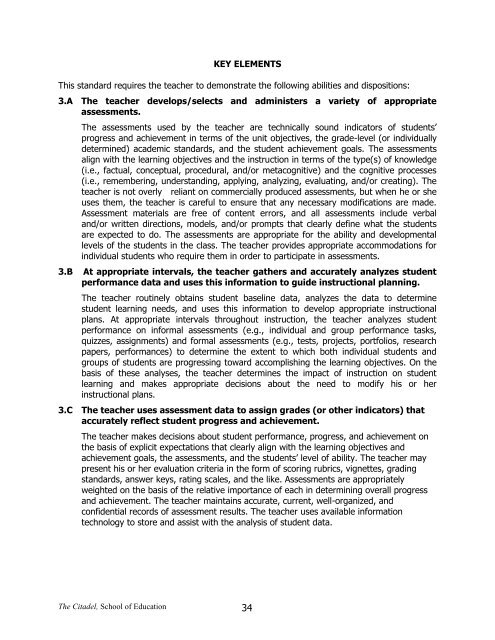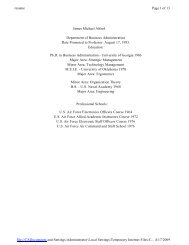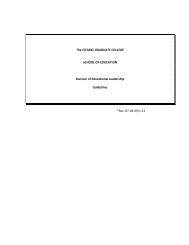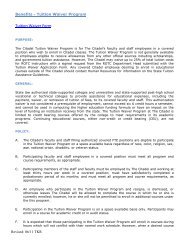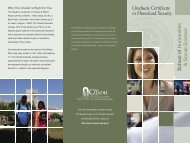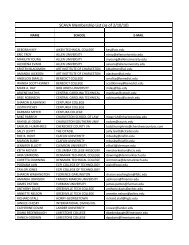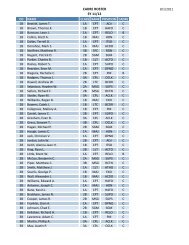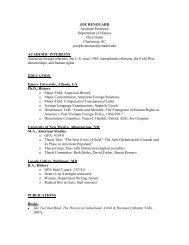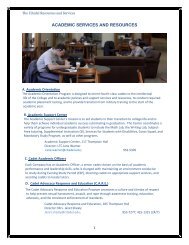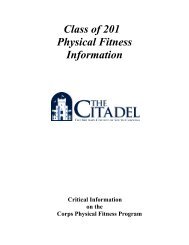Guidelines for Student Teaching Internship - The Citadel
Guidelines for Student Teaching Internship - The Citadel
Guidelines for Student Teaching Internship - The Citadel
You also want an ePaper? Increase the reach of your titles
YUMPU automatically turns print PDFs into web optimized ePapers that Google loves.
KEY ELEMENTSThis standard requires the teacher to demonstrate the following abilities and dispositions:3.A <strong>The</strong> teacher develops/selects and administers a variety of appropriateassessments.<strong>The</strong> assessments used by the teacher are technically sound indicators of students’progress and achievement in terms of the unit objectives, the grade-level (or individuallydetermined) academic standards, and the student achievement goals. <strong>The</strong> assessmentsalign with the learning objectives and the instruction in terms of the type(s) of knowledge(i.e., factual, conceptual, procedural, and/or metacognitive) and the cognitive processes(i.e., remembering, understanding, applying, analyzing, evaluating, and/or creating). <strong>The</strong>teacher is not overly reliant on commercially produced assessments, but when he or sheuses them, the teacher is careful to ensure that any necessary modifications are made.Assessment materials are free of content errors, and all assessments include verbaland/or written directions, models, and/or prompts that clearly define what the studentsare expected to do. <strong>The</strong> assessments are appropriate <strong>for</strong> the ability and developmentallevels of the students in the class. <strong>The</strong> teacher provides appropriate accommodations <strong>for</strong>individual students who require them in order to participate in assessments.3.B At appropriate intervals, the teacher gathers and accurately analyzes studentper<strong>for</strong>mance data and uses this in<strong>for</strong>mation to guide instructional planning.<strong>The</strong> teacher routinely obtains student baseline data, analyzes the data to determinestudent learning needs, and uses this in<strong>for</strong>mation to develop appropriate instructionalplans. At appropriate intervals throughout instruction, the teacher analyzes studentper<strong>for</strong>mance on in<strong>for</strong>mal assessments (e.g., individual and group per<strong>for</strong>mance tasks,quizzes, assignments) and <strong>for</strong>mal assessments (e.g., tests, projects, portfolios, researchpapers, per<strong>for</strong>mances) to determine the extent to which both individual students andgroups of students are progressing toward accomplishing the learning objectives. On thebasis of these analyses, the teacher determines the impact of instruction on studentlearning and makes appropriate decisions about the need to modify his or herinstructional plans.3.C <strong>The</strong> teacher uses assessment data to assign grades (or other indicators) thataccurately reflect student progress and achievement.<strong>The</strong> teacher makes decisions about student per<strong>for</strong>mance, progress, and achievement onthe basis of explicit expectations that clearly align with the learning objectives andachievement goals, the assessments, and the students’ level of ability. <strong>The</strong> teacher maypresent his or her evaluation criteria in the <strong>for</strong>m of scoring rubrics, vignettes, gradingstandards, answer keys, rating scales, and the like. Assessments are appropriatelyweighted on the basis of the relative importance of each in determining overall progressand achievement. <strong>The</strong> teacher maintains accurate, current, well-organized, andconfidential records of assessment results. <strong>The</strong> teacher uses available in<strong>for</strong>mationtechnology to store and assist with the analysis of student data.<strong>The</strong> <strong>Citadel</strong>, School of Education 34


